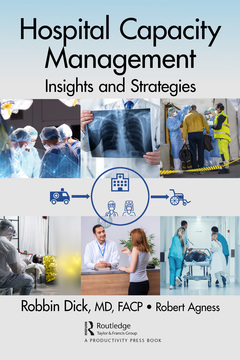Hospital Capacity Management Insights and Strategies
Auteurs : Dick Robbin, Agness Robert

Hospital Capacity Management: Insights and Strategies details many of the key processes, procedures, and administrative realities that make up the healthcare system we all encounter when we visit the ED or the hospital. It walks through, in detail, how these systems work, how they came to be this way, why they are set up as they are, and then, in many cases, why and how they should be improved right now. Many examples pulled from the lifelong experiences of the authors, published studies, and well-documented case studies are provided, both to illustrate and support arguments for change.
First and foremost, it is necessary to remember that the mission of our healthcare system is to take care of patients. This has been forgotten at times, causing many of the issues the authors discuss in the book including hospital capacity management. This facet of healthcare management is absolutely central to the success or failure of a hospital, both in terms of its delivery of care and its ability to survive as an institution. Poor hospital capacity management is a root cause of long wait times, overcrowding, higher error rates, poor communication, low satisfaction, and a host of other commonly experienced problems. It is important enough that when it is done well, it can completely transform an entire hospital system.
Hospital capacity management can be described as optimizing a hospital?s bed availability to provide enough capacity for efficient, error-free patient evaluation, treatment, and transfer to meet daily demand. A hospital that excels at capacity management is easy to spot: no lines of people waiting and no patients in hallways or sitting around in chairs. These hospitals don?t divert incoming ambulances to other hospitals; they have excellent patient safety records and efficiently move patients through their organization. They exist but are sadly in the minority of American hospitals. The vast majority are instead forced to constantly react to their own poor performance. This often results in the building of bigger and bigger institutions, which, instead of managing capacity, simply create more space in which to mismanage it. These institutions are failing to resolve the true stumbling blocks to excellent patient care, many of which you may have experienced firsthand in your own visit to your hospital. It is the hope of the authors that this book will provide a better understanding of the healthcare delivery system.
Letter from the Author. About the Authors. Introduction. 1 Hospital Priorities. 2 Bed Assignment. 3 Inpatient and Outpatient. 4 Emergency Department. 5 Types of Hospital Beds. 6 Capacity Management Strategies. 7 Discharging Patients. 8 Surgical Short Stay Units. 9 Hospital Capacity Management Metrics. 10 Complex Care Patients. 11 Integrated Patient Care. 12 Additional Capacity Management Programs. 13 Discharges before Noon. 14 Leveling. 15 Ancillary Demand Staffing. 16 Surge. 17 Starting a Patient Flow Team. 18 Optimal Hospital Operational Strategies. 19 Process Improvement. 20 Conclusion. Bibliography. Glossary. Index.
Robbin Dick, MD, FACP started his career in 1988 working in the Emergency Department and trained in Internal Medicine. This role served him well in developing concepts and principles around efficiency and process improvement. Robbin developed the first recognized observation unit in NY State to improve ED efficiency in 1996 which started him on the journey of observation medicine and hospital capacity management. In 2003, he joined the University of Rochester Emergency Department and implemented and managed a 36-bed observation unit. In 2009, he had the opportunity to focus on the use of Lean-Six-Sigma concepts in hospital capacity management. As Vice President of Clinical Efficiency, Dr. Dick developed new models of care delivery and integration. His professional work career includes being Director of Observation Services managing the Observation Service line for Medical Emergency Professionals across the state of Maryland.
In 2016, his company joined USACS (US Acute Care Solutions) where Robbin served as Chief of Observation Services for the organization until October, 2018. During his time with USACS, he developed a National Observation Service Line which included well-defined protocols, a robust teaching module based off a MKSAP (Medical Knowledge Self-Assessment Program), testing guidelines, a peer-review process, electronic I-PAD patient satisfaction program and national oversite of the Observation Programs operational development. USACS currently has over 15 Observation units with over 70,000 encounters yearly and is the largest Observation program in the United States. Currently, Robbin’s focus is on consultative services in Observation Medicine and Hospital Capacity Management.
Robert Agness, BA is an experienced professional in operational management. He received Lean Sigma training under Shingo Ztisu trainers at Eastman Kodak’s Lean Institute early in his career. His role at Kodak involved the application of Lean Sigma principles restructu
Date de parution : 03-2021
15.2x22.9 cm
Date de parution : 03-2021
15.2x22.9 cm
Thèmes de Hospital Capacity Management :
Mots-clés :
Capacity management strategies; Patient care; Hospital capacity management; Healthcare system; Bed assignment; ICU Bed; Inpatient Care Units; Complex Care Patients; Integrated Patient Care; Cath Lab; Artificial Variability; Inpatient Bed; Pcp Visit; ED Provider; Acute Inpatient Admission; Medication Reconciliation; Observation Patients; Surg Beds; Emergency Department Admissions; ED Bed; Orthopedic Unit; ICU Patient; ICU Mortality; Inpatient Los; Patient Los; ICU Setting; PICC Line; DRG System



